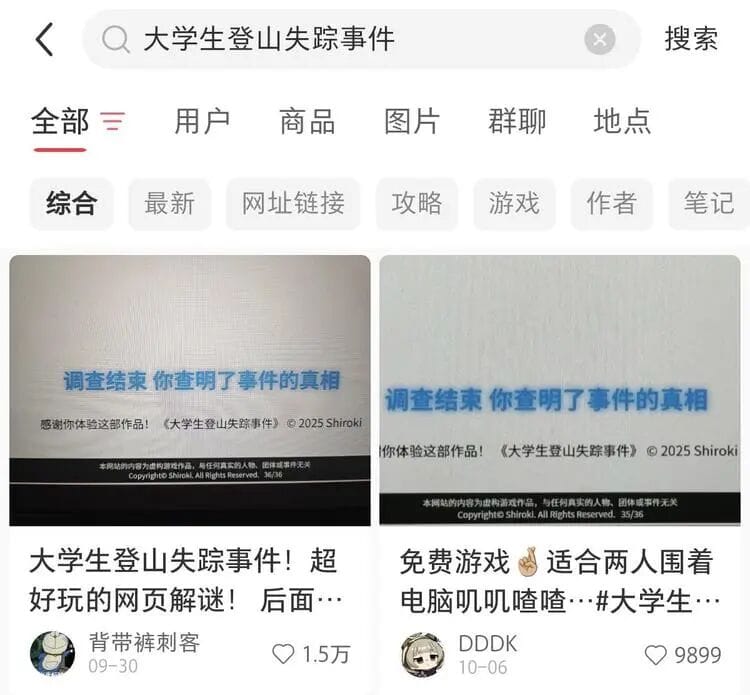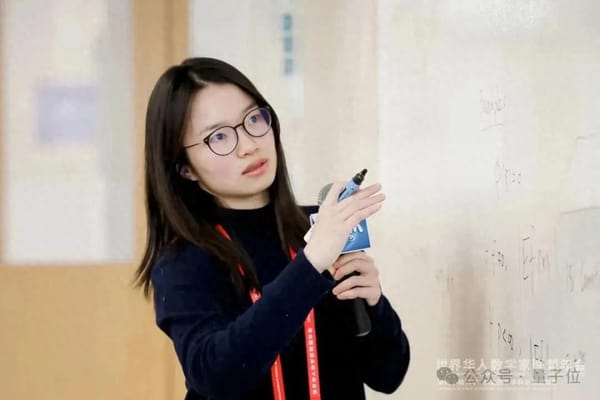He Created a Game with Doubao and Wenxin Yiyan That Tens of Thousands Love | Conversation with Game Creator Galaxy Lamp

October 28, 2025 · Beijing
Have We Really Kept Pace with AI?


When was the last time you carefully read an entire web page?
In the age of information overload, attention spans are shorter than ever. Many now watch even short videos at double speed. Yet not long ago, players found themselves fully absorbed—reading through 36 full web pages inside a game.
The hook? Not high-end web tech, but the desire to discover the truth.
---
The Game That Took Over the Web
In Fall 2025, _The Missing College Hiker Incident_ exploded in popularity—no flashy graphics or big studio marketing. Players landed on what looked like a restaurant homepage, only to be pulled into a layered mystery.
- Bilibili livestream replays reached tens of thousands of views.
- Xiaohongshu comment sections filled with “Stuck in the menu at 2 a.m.”

You begin searching for your missing brother—expecting complex puzzles. Instead, you find a simple, clean AI‑styled site. Beneath its plain design lies a hidden challenge: enter the right keywords, peel back layers, and connect clues.
The interactive web format creates a more immersive "participatory deduction" feel than reading a novel. Solving a key clue delivers an adrenaline rush akin to cracking a tough exam question.

---
The Solo Creator Behind the Mystery
The surprise? Creator Galactic Lamp isn’t a programmer or artist. Using a toolkit of AI services—Doubao, Gemini, Wenxinyiyan—they handled everything from concept to visuals.
Unlike most brief AI experiments, this game kept players engaged and motivated to share.
Game link:
https://missing.shiroki-y.top/introduction.html
Below is a Q&A with Galactic Lamp on human–AI co‑creation.
---
From Gamer to AI Game Maker
Q: Introduce yourself.
> I moved to Japan about 2.5–3 years ago. Before that, I worked in China doing China–Japan game business coordination. In Tokyo, my role was more clerical—never touching “core game-making.” That gap inspired me to try creating my own game.
---
Inspiration: From Restaurant Menus to Folklore
Q: Why make this game?
> A Japanese web project sparked the idea—it wasn’t a typical game. In one example, a lost wallet is auctioned, and each item inside becomes a puzzle clue, letting you reconstruct the owner’s life.
> I also admired Japanese ARG team The Fourth Boundary, who mix narrative with offline props. Without the resources for offline play, I adapted it into a web‑based puzzle format.
---
Why a Restaurant Homepage?
> It's everyday and familiar—players drop their guard faster. From there, I lead them into deeper, darker lore. Plus, I wanted to showcase Henan cuisine from my hometown.
The story’s central folklore concept is luck—personified as a deity with a “law of conservation,” where gains in one place mean losses elsewhere.
---
Building a Full Game With AI
Step 1 — Scriptwriting
- AI can't yet define what is "interesting."
- I wrote the story and used Doubao to check fluency and logic.
Step 2 — Page Design Checklists
- Define keywords, narrative beats, emotional cues per page.
- Sometimes insert “scare pages” deliberately.
Step 3 — AI-Driven Production
- Programming: Started with Google Gemini, later switched to GitHub Copilot for the sequel.
- Visuals: Used Baidu's Wenxin AI for Chinese life-scene accuracy.
---
AI Pitfalls & Debugging
Common issues:
- Low expectations are crucial—requires multiple iterations.
- “Forgetfulness”: AI may break existing code when editing.
- Image generation struggles with horror motifs and maps—requires prompt engineering or “reverse-engineering” from references.
---
Pleasant Surprises
- AI implemented complex “search keyword → hidden page” redirects and visual effects with minimal direction.
- Backend deployment is still out of reach without manual setup.
- AI doesn’t truly “see” rendered layouts—spatial edits still take more human effort.
---
Storytelling & Copywriting
- AI-generated mysteries felt cliched, so I led story creation.
- I did use AI for certain ancient-text style segments and to add literary nuance at the ending, guiding it with long, detailed prompts.
---
Player Acceptance of AI Creations
AI art remains controversial—players worry about lost livelihoods.
Programming and UI design are less noticeably AI-driven and more readily accepted.
In my case, AI’s clean, restrained UI won praise from players.
---
Clues & Keywords: Balancing Difficulty
Keywords should feel mundane yet reveal deeper meaning.
Early “positive feedback” from external searches could help players learn they work, preventing frustration.
EX pages add:
- Atmosphere akin to Lovecraftian “taboo” dread.
- Lore connections, e.g., linking customer names to hidden clues.
- Extended narrative and thematic depth.
---
The Sequel Is Coming
> “It’s already in the works—my hands are sparking with friction.”


---
Final Thoughts
Human-led vision + AI execution is the emerging creative workflow.
Platforms like AiToEarn官网 enable creators to:
- Generate AI content.
- Publish across multiple channels.
- Analyze performance.
- Monetize at scale.
The future could see AI as thinking NPCs—reactive, real-time dialogue partners—opening up truly “living worlds,” as long as they remain on track.
---
Key takeaway: AI can empower solo creators to produce polished, immersive works, but human direction and storytelling still drive engagement. Creators must balance AI integration with player trust and acceptance.



